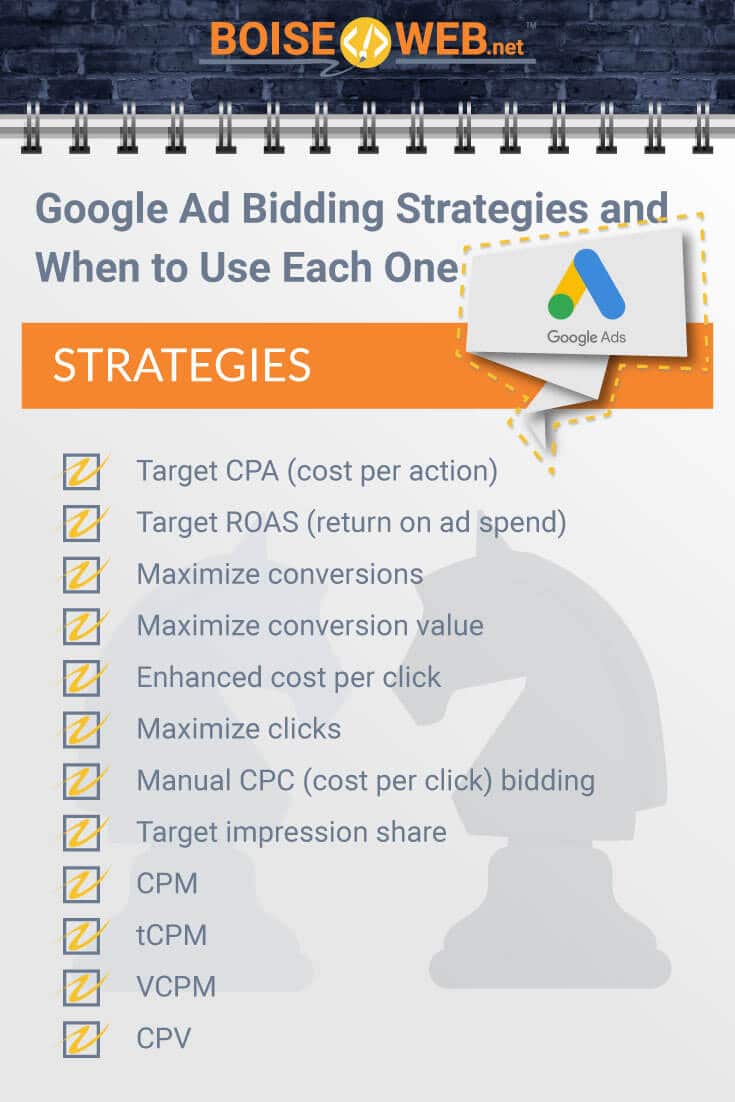There are a lot of different bidding strategies that are at your disposal when using Google Ads, but deciding which bidding strategy best suits your campaign and will most greatly benefit you and your company can be a stressful process. This article will walk you through all of the available Google Ad bidding strategies and when each one should be used.
Google Ad Bidding Strategies:
- Target CPA (cost per action)
- Target ROAS (return on ad spend)
- Maximize conversions
- Maximize conversion value
- Enhanced cost per click
- Maximize clicks
- Manual CPC (cost per click) bidding
- Target impression share
- CPM
- tCPM
- vCPM
- CPV
Determining a Bid Strategy Based on Goals
Considering your goals when setting up a bid strategy is incredibly important – what do you want to get out of this campaign? Do you want people to simply click on your ad and be taken to your website? Do you want people to not only click on your ad but make a purchase or view a video? These goals are crucial to understand and keep in mind so that your bidding strategy will reflect what you are looking to achieve throughout the campaign.
Focus on Conversions
If the main goal of your campaign is to bring in conversions or sales then Smart Bidding is the way to go. Smart Bidding takes a lot of the heavy lifting out of your budget by using automated strategies and machine learning to optimize your campaign for conversions. It also factors in a wide variety of auction signals in order to capture the most accurate information for your ads. There are five different Smart Bidding strategies that you can use when focusing on conversions with your Google Ads.
- Target CPA (cost per action) – Target CPA allows you to increase your conversions by setting a target CPA, or target cost you want to spend per action. Google will then auto bid based on your target CPA to maximize your conversions without going over budget.
- Target ROAS (return on ad spend) – Target ROAS works to increase your conversions in an attempt to reach a target ROAS. You also set a target CPA for this bidding strategy so that you are not spending too much money per action while still improving your ROAS.
- Maximize Conversions – Maximize conversions works to maximize your conversions as effectively as possible without applying a cost per action. It works off of a target ROAS to get you as many conversions for your money as possible. This can get you a lot of conversions very quickly but can also run through your budget in record amounts of time.
- Maximize Conversion Value – Maximize conversion value is similar to maximize conversions in the way that it works without a CPA to get you the most conversions possible. Unlike maximize conversions, however, maximize conversion value does not work off of a target ROAS.
- Enhanced Cost Per Click (ECPC) – ECPC is an optional feature that you can use with manual CPC bidding that will automatically adjust your manual bids in order to maximize your conversions.
Focus on Clicks
If the main focus of your campaign is to gain website traction and generate the most clicks to your site as possible, a cost per click or CPC bidding strategy is the way to go. There are two different CPC bidding strategies.
- Maximize Clicks – Maximize clicks is an automated bidding strategy in which you enter an average daily budget that you would like to spend and Google Ads will automatically adjust your budget in order to generate the most clicks as possible. This bidding strategy is quite simply the easiest and most effective way to generate large numbers of clicks to your website.
- Manual CPC Bidding – Manual CPC bidding gives you the opportunity to adjust your daily budget yourself. You can set budgets for entire ad groups, or have differing budgets down to each individual keyword. This strategy can work if you have found certain keywords or ad groups to be more profitable, but it very labor intensive and hands on to keep running on a regular basis.
Focus on Visibility
If the main focus of your campaign is visibility there are several different bid strategies that can help you get the highest possible number of people to see your ads.
- Target Impression Share – Target impression share automatically generates bids based on each individual search in order to get your ad to the most visible place on the page, often at the very top. This will effectively show your ads to as many people as possible but can be very expensive.
- CPM – CPM bid strategy allows you to pay based on the number of impressions your ad receives, or in other words you’ll pay for how many times your ad is shown on YouTube or the Google Display Network.
- tCPM – This is a bidding strategy that allows you to set a pre-determined budget for what you are willing to pay per one thousand impressions. Google Ads then automatically optimizes your bids according to your campaign’s unique needs. This bidding strategy allows you to only pay your budget or less while still reaching as many people as possible.
- vCPM – This is a manual bidding strategy that is designed to increase your reach as much as possible but is not necessarily targeted towards generating clicks or any interaction with your ads. This strategy is best if your main goal is awareness focused and you simply want people to become more aware of your brand.
Focus on Views
- CPV – This bidding strategy is only applicable for video ads and allows you to set a budget of the maximum amount of money you are willing to spend per view or click on your video ad.
Commonly Asked Questions:
What should my budget be?
While it greatly varies between different business and different campaigns, I tend to set most of my campaigns at a starting budget of $5. I watch my new campaigns closely and if they perform well, I might raise the budget. However, if they do not perform well, I make sure to quickly fix the problem or lower the budget if the campaign is hurting the overall account.
How do I know if my campaign is performing well?
While what is considered “good performance” greatly varies from business to business, there are a few things to look for when you’re first getting started. A CTR (click through rate) of 2% or higher is considered a good interaction rate with your website, and anything below a 1% is very bad. When looking at conversions, the best tool to use is the Conversion Value/Cost. This calculates your ROAS (return on ad investment) and a ROAS higher than 4 is generally considered good.
How many campaigns should I set up?
Start small, especially if you’re new to Google Ads. Set up one campaign at a time and then give that campaign a week or two to find its feet. If it’s performing well, great! If not, you know that it’s time to go back to the drawing board. From there you can start to determine which ads work for you and which ones don’t, the most effective way to market your brand, and which products or services to pay more attention to based on what your customers are actually purchasing.
Related Articles:




